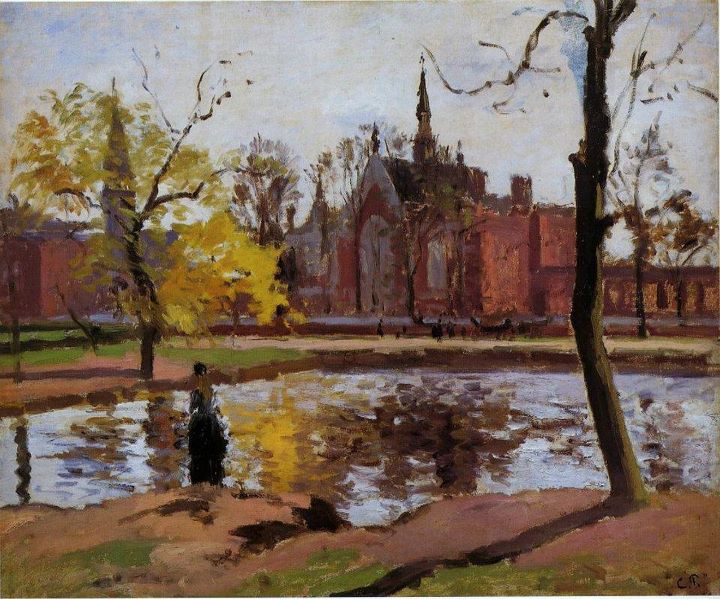Francesco Trevisani (Italian Rococo Era painter, 1656-1746) | An allegory of music
The word Music derives from Greek μουσική (mousike; "art of the Muses").
In Greek mythology, the nine Muses were the goddesses who inspired literature, science, and the arts and who were the source of the knowledge embodied in the poetry, song-lyrics, and myths in the Greek culture.
Jean Delville (Belgian Symbolist painter, 1867-1953) | Allegory of Music
According to the Online Etymological Dictionary, the term "music" is derived from "mid-13c., musike, from Old French musique (12c.) and directly from Latin musica "the art of music", also including poetry (also [the] source of Spanish música, Italian musica, Old High German mosica, German Musik, Dutch muziek, Danish musik)".
This is derived from the "...Greek mousike (techne) "(art) of the Muses", from fem. of mousikos "pertaining to the Muses," from Mousa "Muse" Modern spelling [dates] from [the] 1630s.
In classical Greece, [the term "music" refers to] any art in which the Muses presided, but especially music and lyric poetry.
Francois Le Moyne (French Rococo Era painter, 1688-1737) | Allegory of Music
Albert Thomas (French 19th Century artist) | Allegory of Music
Laurent de La Hyre (French Baroque Era painter, 1606-1656) | Allegory of Music, 1649 | The Metropolitan Museum of Art
Giuseppe Nogari (Italian Rococo Era painter, 1699-1766) | Allegory of Music
Francesco de Mura (Italian Baroque Era painter, 1696-1782) | Allegory of Music
Pietro Paolini (Italian Baroque Era painter, 1603-1681) | Allegory of Music
Simone Cantarini (Italian Baroque Era painter, 1612-1648) | Allegory of Music
Tintoretto (Italian Mannerist painter, 1518-1594) | Allegory of Music
Antoine Coypel (French Baroque Era painter, 1661-1722) | Allegory of Music
Caravaggio (Italian Baroque Era painter, 1571-1610) | Allegory of Music
Franco-Flemish School mid-16th century | Allegory of Music
Florentine School 18th Century | Allegory of Music
La Musica (dal sostantivo greco μουσική) è il prodotto dell'arte di ideare e produrre, mediante l'uso di strumenti appositi o della voce, una successione organizzata di suoni che risultino piacevoli all'orecchio.
Più tecnicamente la musica consiste nell'organizzazione dei suoni, dei rumori e dei silenzi nel corso del tempo e nello spazio.
Si tratta di arte in quanto complesso di norme pratiche adatte a conseguire determinati effetti sonori, che riescono ad esprimere l'interiorità dell'individuo che produce la musica e dell'ascoltatore; si tratta di scienza in quanto studio della nascita, dell'evoluzione e dell'analisi dell'intima struttura della musica.
Il generare suoni avviene mediante il canto o mediante l'utilizzo di strumenti musicali che, attraverso i principi dell'acustica, provocano la percezione uditiva e l'esperienza emotiva voluta dall'artista.
Filippino Lippi (Italian Renaissance painter, 1457-1504) | Allegory of Music, 1500 (detail)
Filippino Lippi (Italian Renaissance painter, 1457-1504) | Allegory of Music, 1500
Il significato del termine musica non è comunque univoco ed è molto dibattuto tra gli studiosi per via delle diverse accezioni utilizzate nei vari periodi storici.
Etimologicamente il termine musica deriva dall'aggettivo greco μουσικός/musikòs, relativo alle Muse, figure della mitologia greca e romana, riferito in modo sottinteso a tecnica, anch'esso derivante dal greco τέχνη/techne.
In origine il termine non indicava una particolare arte, bensì tutte le arti delle Muse, e si riferiva a qualcosa di "perfetto".
Le macro-categorie della colta, leggera ed etnica si articolano in diversi generi e forme musicali che utilizzano sistemi quali armonia, melodia, tonalità e polifonia.
Nell'antica Grecia nacque una materia, una scienza, che estraeva anch'essa queste ultime due, la matematica, che è parte fondamentale della musica, come Pitagora capì, per la relazione tra rapporti frazionari e suono.
Platone affermò che, come la ginnastica serviva ad irrobustire il corpo, la musica doveva arricchire l'animo.
Attribuiva alla musica una funzione educativa, come la matematica: secondo lui bisognava saper scegliere fra tanto e poco, fra più o meno, fra bene o male, per arrivare all'obiettivo finale.
James Longacre Wood (American painter, 1863-1938) | Allegory of Music
François Boucher (French Rococo Era painter, 1703-1770) | Allegory of Music
François Boucher (French Rococo Era painter, 1703-1770) | Allegory of Music





















.jpg)




































